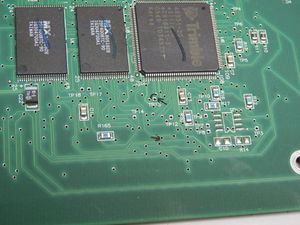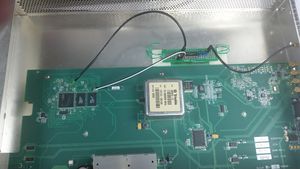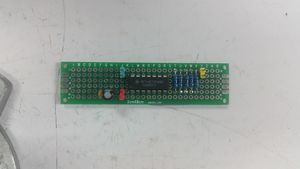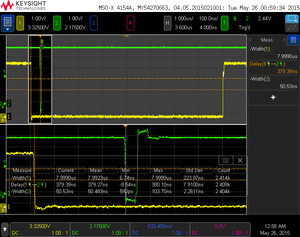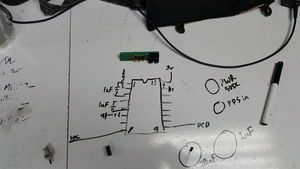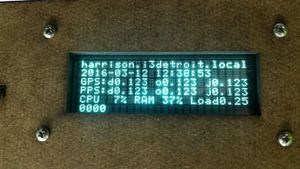Nortel GPSTM
| Nortel GPSTM | |
|---|---|
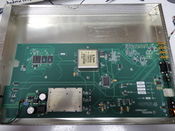
| |
| Name | Nortel GPSTM |
| Zone | Infrastructure
|
| Owner | Nate Bezanson |
| Make Model | Nortel GPSTM |
| Part Number | NTBW50AA-11 |
| Date Acquired | |
| Storage Location | Server Rack |
| Authorization Required | No |
| Status | Running |
| Value | $150 |
| IP Address | 10.13.0.95 |
| MAC Address | 00:01:2e:49:5d:ba |
| Hostname | harrison.i3detroit.local |
| Documentation | Manuals |
| Other References | |
Contents
Intro
The Nortel GPSTM is a GPS disciplined, temperature controlled oscillator and time source. The current purpose is for it to provide a high accuracy, high precision time source for the space and provide a 10Mhz reference clock for the E-Room.
Rules
Instructions
Maintenance Info
FAQ
ToDo
- Use distribution amplifier to route 10Mhz/PPS to E-Room
- Front panel VFD wiring/software
Integrate with ntpsecMount antenna48-hour site surveyAdd PPS output from marked via.Rackmount case
PPS Discovery
Amelia Meyer and Benjamin Fedorka found inside the unit a PPS output pin, which is exciting because the native output on the unit of PP2S is unsuitable for ntpd.
After some tracing, a more-suitable location near several ground points was located at TP13.
Discussion here: https://www.febo.com/pipermail/time-nuts/2015-May/092151.html
And here's the prior work Ignacio EB4APL refers to, on a different version of the unit (NTGS50AA): https://www.febo.com/pipermail/time-nuts/2014-November/088332.html
Antenna location
23:10, 12 March 2016 (12-hours, ish): delta of 239.8mm in latlong, 502.9mm alt
- Latitude
- 42.4538034°N
- Longitude
- 83.1138062°W
- Altitude
- 160.73505694 m
13:40, 27 June 2015 (48-hour site survey)
- Latitude
- 42.4538028°N
- Longitude
- 83.1138090°W
- Altitude
- 161.23804233 m
NTP stratum-1 server
- Hostname
- harrison.i3detroit.local
- IP address
- 10.13.0.95
- Services
-
- NTP on UDP port 123
LCD Front Panel
Noritake CU24063-Y100 Serial VFD cable
Attach FTDI adapter to MAX232 board to VFD CN2 (1x6 0.1" header)
| PC Pin | PC Function | VFD Pin | VFD Function |
|---|---|---|---|
| 10 | 5VDC | 1 | VCC |
| 5 | TXD | 2 | SIN |
| 9 | GND | 3 | GND |
| 6 | CTS | 4 | SBUSY |
| NC | NC | 5 | NC |
| NC | NC | 6 | /RESET |
Example VFD Text
Generated by the following script, depending on psutil, dateutil, and ntpsec
#!/usr/bin/env python
# ~*~ coding: utf-8 ~*~
import socket
from datetime import datetime
import dateutil.tz
import psutil
import os
import ntp.packet
import ntp.util
import ntp.ntpc
import ntp.version
import ntp.control
import ntp.magic
if __name__ == '__main__':
# Hostname
output = '%24s'%(socket.getfqdn())
# ISO8601 in local time
output +='|%24s'%(datetime.now(dateutil.tz.tzlocal()).strftime('%Y-%m-%d %H:%M:%S%z'))
# NTP refclock statistics
session = ntp.packet.ControlSession()
session.debug=0
session.logfp=None
session.openhost('localhost')
peers = session.readstat()
gps = []
pps = []
for peer in peers:
stats = session.readvar(peer.associd,raw=True)
if stats['refid'][0] == 'PPS':
pps.append(stats['delay'][1][:5])
pps.append(stats['offset'][1][:5])
pps.append(stats['jitter'][1][:5])
pps = tuple(pps)
if stats['refid'][0] == 'GPS':
gps.append(stats['delay'][1][:5])
gps.append(stats['offset'][1][:5])
gps.append(stats['jitter'][1][:5])
gps = tuple(gps)
output +='|GPS:d% 4s o% 4s j% 4s'%gps
output +='|PPS:d% 4s o% 4s j% 4s'%pps
# CPU, RAM, and load average
cpu = psutil.cpu_percent()
ram = psutil.virtual_memory().percent
load = os.getloadavg()[0]
output +='|CPU%3d%% RAM%3d%% Load%3.2f'%(cpu,ram,load)
# System temperatures
temps = psutil.sensors_temperatures()
sys_t = temps['acpitz'][0].current
c0_t = temps['coretemp'][0].current
c1_t = temps['coretemp'][1].current
output +='|C0+%3.1fC C1+%3.1fC SY+%2dC'%(c0_t,c1_t,sys_t)
print output.replace('|','\n')
| h | a | r | r | i | s | o | n | . | i | 3 | d | e | t | r | o | i | t | . | l | o | c | a | l |
|---|---|---|---|---|---|---|---|---|---|---|---|---|---|---|---|---|---|---|---|---|---|---|---|
| 2 | 0 | 1 | 7 | - | 0 | 7 | - | 0 | 4 | 0 | 0 | : | 5 | 2 | : | 2 | 8 | - | 4 | : | 0 | 0 | |
| G | P | S | : | r | 3 | 7 | 7 | o | 1 | 6 | . | 9 | 7 | j | 1 | . | 2 | 3 | 4 | 5 | |||
| P | P | S | : | r | 3 | 7 | 7 | o | - | 4 | 2 | . | 1 | 2 | j | 1 | . | 2 | 3 | 4 | 5 | ||
| C | P | U | 7 | % | R | A | M | 3 | 7 | % | L | o | a | d | 0 | . | 2 | 3 | |||||
| C | 0 | + | 5 | 3 | . | 0 | C | C | 1 | + | 5 | 6 | . | 0 | C | S | Y | + | 4 | 4 | C |

